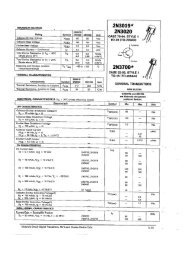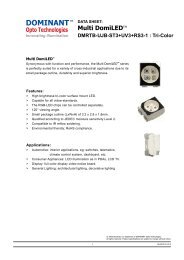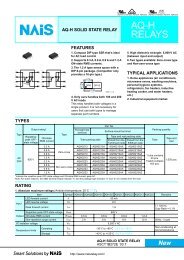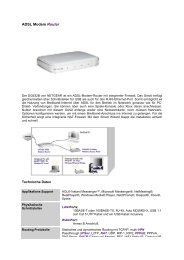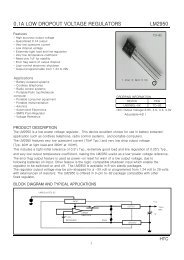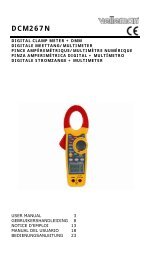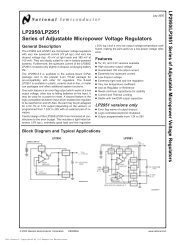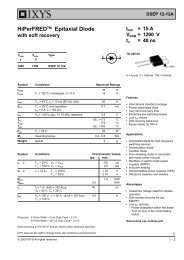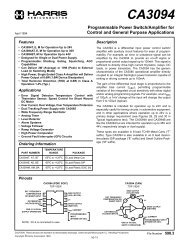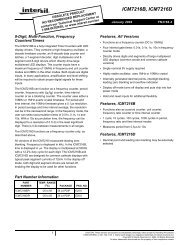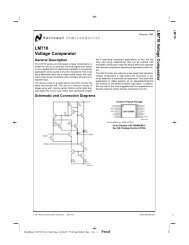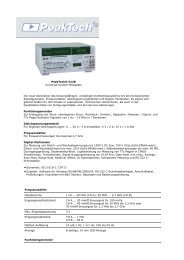Designing With the SN54/74LS123 - EBG - Darmstadt
Designing With the SN54/74LS123 - EBG - Darmstadt
Designing With the SN54/74LS123 - EBG - Darmstadt
You also want an ePaper? Increase the reach of your titles
YUMPU automatically turns print PDFs into web optimized ePapers that Google loves.
<strong>Designing</strong> <strong>With</strong> <strong>the</strong> <strong>SN54</strong>/<strong>74LS123</strong><br />
SDLA006A<br />
March 1997<br />
1
2<br />
IMPORTANT NOTICE<br />
Texas Instruments (TI) reserves <strong>the</strong> right to make changes to its products or to discontinue any<br />
semiconductor product or service without notice, and advises its customers to obtain <strong>the</strong> latest<br />
version of relevant information to verify, before placing orders, that <strong>the</strong> information being relied<br />
on is current.<br />
TI warrants performance of its semiconductor products and related software to <strong>the</strong> specifications<br />
applicable at <strong>the</strong> time of sale in accordance with TI’s standard warranty. Testing and o<strong>the</strong>r quality<br />
control techniques are utilized to <strong>the</strong> extent TI deems necessary to support this warranty.<br />
Specific testing of all parameters of each device is not necessarily performed, except those<br />
mandated by government requirements.<br />
Certain applications using semiconductor products may involve potential risks of death,<br />
personal injury, or severe property or environmental damage (“Critical Applications”).<br />
TI SEMICONDUCTOR PRODUCTS ARE NOT DESIGNED, INTENDED, AUTHORIZED, OR<br />
WARRANTED TO BE SUITABLE FOR USE IN LIFE-SUPPORT APPLICATIONS, DEVICES<br />
OR SYSTEMS OR OTHER CRITICAL APPLICATIONS.<br />
Inclusion of TI products in such applications is understood to be fully at <strong>the</strong> risk of <strong>the</strong> customer.<br />
Use of TI products in such applications requires <strong>the</strong> written approval of an appropriate TI officer.<br />
Questions concerning potential risk applications should be directed to TI through a local SC<br />
sales office.<br />
In order to minimize risks associated with <strong>the</strong> customer’s applications, adequate design and<br />
operating safeguards should be provided by <strong>the</strong> customer to minimize inherent or<br />
procedural hazards.<br />
TI assumes no liability for applications assistance, customer product design, software<br />
performance, or infringement of patents or services described herein. Nor does TI warrant or<br />
represent that any license, ei<strong>the</strong>r express or implied, is granted under any patent right, copyright,<br />
mask work right, or o<strong>the</strong>r intellectual property right of TI covering or relating to any combination,<br />
machine, or process in which such semiconductor products or services might be or are used.<br />
Copyright © 1997, Texas Instruments Incorporated
Contents<br />
Title Page<br />
Introduction . . . . . . . . . . . . . . . . . . . . . . . . . . . . . . . . . . . . . . . . . . . . . . . . . . . . . . . . . . . . . . . . . . . . . . . . . . . . . . . . . . . . . . . 1<br />
Features . . . . . . . . . . . . . . . . . . . . . . . . . . . . . . . . . . . . . . . . . . . . . . . . . . . . . . . . . . . . . . . . . . . . . . . . . . . . . . . . . . . . . . . . . . . 1<br />
Rules for Operation . . . . . . . . . . . . . . . . . . . . . . . . . . . . . . . . . . . . . . . . . . . . . . . . . . . . . . . . . . . . . . . . . . . . . . . . . . . . . . . . . 2<br />
Output Pulse Duration . . . . . . . . . . . . . . . . . . . . . . . . . . . . . . . . . . . . . . . . . . . . . . . . . . . . . . . . . . . . . . . . . . . . . . . . . . . 3<br />
Output Pulse Duration Versus Supply Voltage . . . . . . . . . . . . . . . . . . . . . . . . . . . . . . . . . . . . . . . . . . . . . . . . . . . . . . . . . 4<br />
Special Considerations . . . . . . . . . . . . . . . . . . . . . . . . . . . . . . . . . . . . . . . . . . . . . . . . . . . . . . . . . . . . . . . . . . . . . . . . . . . . . . 5<br />
Device-to-Device Variation . . . . . . . . . . . . . . . . . . . . . . . . . . . . . . . . . . . . . . . . . . . . . . . . . . . . . . . . . . . . . . . . . . . . . . . 7<br />
<strong>74LS123</strong>N/J Device-to-Device Variation . . . . . . . . . . . . . . . . . . . . . . . . . . . . . . . . . . . . . . . . . . . . . . . . . . . . . . . . . . . . . 8<br />
Applications . . . . . . . . . . . . . . . . . . . . . . . . . . . . . . . . . . . . . . . . . . . . . . . . . . . . . . . . . . . . . . . . . . . . . . . . . . . . . . . . . . . . . . 10<br />
Delayed-Pulse Generator <strong>With</strong> Override . . . . . . . . . . . . . . . . . . . . . . . . . . . . . . . . . . . . . . . . . . . . . . . . . . . . . . . . . . . . 10<br />
Missing-Pulse Detector . . . . . . . . . . . . . . . . . . . . . . . . . . . . . . . . . . . . . . . . . . . . . . . . . . . . . . . . . . . . . . . . . . . . . . . . . 11<br />
Low-Power Pulse Generator . . . . . . . . . . . . . . . . . . . . . . . . . . . . . . . . . . . . . . . . . . . . . . . . . . . . . . . . . . . . . . . . . . . . . 12<br />
Negative/Positive Edge-Triggered One-Shot . . . . . . . . . . . . . . . . . . . . . . . . . . . . . . . . . . . . . . . . . . . . . . . . . . . . . . . . . 13<br />
Pulse-Duration Detector . . . . . . . . . . . . . . . . . . . . . . . . . . . . . . . . . . . . . . . . . . . . . . . . . . . . . . . . . . . . . . . . . . . . . . . . . 14<br />
Frequency Discriminator . . . . . . . . . . . . . . . . . . . . . . . . . . . . . . . . . . . . . . . . . . . . . . . . . . . . . . . . . . . . . . . . . . . . . . . . 15<br />
Figure<br />
List of Illustrations<br />
Title Page<br />
1 ’LS123 Logic Diagram . . . . . . . . . . . . . . . . . . . . . . . . . . . . . . . . . . . . . . . . . . . . . . . . . . . . . . . . . . . . . . . . . . . . . . . . 1<br />
2 Remote Trimming Circuit . . . . . . . . . . . . . . . . . . . . . . . . . . . . . . . . . . . . . . . . . . . . . . . . . . . . . . . . . . . . . . . . . . . . . . 2<br />
3 Retrigger Pulse-Duration Calculation . . . . . . . . . . . . . . . . . . . . . . . . . . . . . . . . . . . . . . . . . . . . . . . . . . . . . . . . . . . . . 3<br />
4 Multiplier Factor Versus External Capacitor (Cext) . . . . . . . . . . . . . . . . . . . . . . . . . . . . . . . . . . . . . . . . . . . . . . . . . . 3<br />
5 Output Pulse Duration Versus External Timing Capacitance . . . . . . . . . . . . . . . . . . . . . . . . . . . . . . . . . . . . . . . . . . . 4<br />
6 Output Pulse Duration Versus Supply Voltage . . . . . . . . . . . . . . . . . . . . . . . . . . . . . . . . . . . . . . . . . . . . . . . . . . . . . . 4<br />
7 Average Percent Change Versus Pulse-Duration Tolerance . . . . . . . . . . . . . . . . . . . . . . . . . . . . . . . . . . . . . . . . . . . . 5<br />
8 Pulse-Duration Variation Versus Supply Voltage . . . . . . . . . . . . . . . . . . . . . . . . . . . . . . . . . . . . . . . . . . . . . . . . . . . . 6<br />
9 Pulse-Duration Variation Versus Free-Air Temperature . . . . . . . . . . . . . . . . . . . . . . . . . . . . . . . . . . . . . . . . . . . . . . . 6<br />
10 Multiplier Factor Versus Capacitance . . . . . . . . . . . . . . . . . . . . . . . . . . . . . . . . . . . . . . . . . . . . . . . . . . . . . . . . . . . . . 7<br />
11 Delayed-Pulse Generator <strong>With</strong> Override . . . . . . . . . . . . . . . . . . . . . . . . . . . . . . . . . . . . . . . . . . . . . . . . . . . . . . . . . . 10<br />
12 Missing-Pulse Detector . . . . . . . . . . . . . . . . . . . . . . . . . . . . . . . . . . . . . . . . . . . . . . . . . . . . . . . . . . . . . . . . . . . . . . . 11<br />
13 Low-Power Pulse Generator . . . . . . . . . . . . . . . . . . . . . . . . . . . . . . . . . . . . . . . . . . . . . . . . . . . . . . . . . . . . . . . . . . . 12<br />
14 Negative/Positive Edge-Triggered One-Shot . . . . . . . . . . . . . . . . . . . . . . . . . . . . . . . . . . . . . . . . . . . . . . . . . . . . . . 13<br />
15 Pulse-Duration Detector . . . . . . . . . . . . . . . . . . . . . . . . . . . . . . . . . . . . . . . . . . . . . . . . . . . . . . . . . . . . . . . . . . . . . . 14<br />
16 Frequency-Discriminator Circuit . . . . . . . . . . . . . . . . . . . . . . . . . . . . . . . . . . . . . . . . . . . . . . . . . . . . . . . . . . . . . . . . 15<br />
17 ’LS123 Schematic . . . . . . . . . . . . . . . . . . . . . . . . . . . . . . . . . . . . . . . . . . . . . . . . . . . . . . . . . . . . . . . . . . . . . . . . . . .<br />
16<br />
iii
Introduction<br />
The Texas Instruments (TI) <strong>SN54</strong>/<strong>74LS123</strong> dual retriggerable monostable multivibrator is a one-shot device capable of very<br />
long output pulses and up to 100% duty cycle. The ’LS123 also features dc triggering from gated low-level active A and<br />
high-level active B inputs and provides a clear input that terminates <strong>the</strong> output pulse of any predetermined time independent<br />
of timing components, Rext and Cext. The output pulse duration can also be extended by retriggering <strong>the</strong> input prior to <strong>the</strong><br />
termination of an existing output pulse. Retrigger pulses starting before 0.22 Cext (in pF) ns after <strong>the</strong> initial trigger pulse will<br />
be ignored and <strong>the</strong> output duration will remain unchanged.<br />
The B input on an ’LS123 is designed to handle pulses with a transition rate as slow as 0.1 mV/ns, (Schmitt-trigger input) with<br />
jitter-free one-shot action. This capability allows <strong>the</strong> ’LS123 to be used as an interface element between circuits with very<br />
slow-rising output pulses and circuits that require fast-rising input pulses.<br />
Features<br />
• 100% maximum duty cycle<br />
• Dc triggered from active-high or active-low logic inputs<br />
• Input clamp diodes<br />
• Low power dissipation<br />
• Compensated for VCC and temperature variations<br />
Figure 1 is a functional block diagram of <strong>the</strong> ’LS123. Each one-shot has two inputs, one active-low and one active-high, which<br />
allow both leading or trailing edge triggering. When triggered, <strong>the</strong> basic pulse duration can be extended by retriggering <strong>the</strong><br />
gated low-level active A or high-level active B inputs, or <strong>the</strong> pulse duration can be reduced by use of <strong>the</strong> overriding clear.<br />
Therefore, an input cycle time shorter than <strong>the</strong> output cycle time will retrigger <strong>the</strong> ’LS123 and result in a continuously high<br />
Q output.<br />
1A<br />
1B<br />
1CLR<br />
1<br />
2<br />
3<br />
R<br />
Cext<br />
VCC<br />
14 15<br />
Rext<br />
13<br />
4<br />
1Q<br />
1Q<br />
2A<br />
2B<br />
2CLR<br />
9<br />
10<br />
11<br />
Figure 1. ’LS123 Logic Diagram<br />
R<br />
Cext<br />
VCC<br />
6 7<br />
Rext<br />
5<br />
12<br />
2Q<br />
2Q<br />
1
2<br />
FUNCTION TABLE<br />
CLEAR A INPUT B INPUT Q Q<br />
L X X L H<br />
X H X L† H†<br />
X X L L† H†<br />
H L ↑ LHL‡ HLH§<br />
H ↓ H LHL‡ HLH§<br />
↑ L H LHL‡ HLH§<br />
† These lines of <strong>the</strong> functional tables assume that <strong>the</strong><br />
indicated steady-state conditions at <strong>the</strong> A and B<br />
inputs have been set up long enough to complete any<br />
pulse started before <strong>the</strong> setup.<br />
‡ This is a low-to-high-to-low pulse.<br />
§ This is a high-to-low-to-high pulse.<br />
Rules for Operation<br />
1. An external resistor (R ext) and an external capacitor (C ext) are required, as shown in Figure 1, for proper<br />
circuit operation.<br />
NOTE:<br />
For best results, system ground should be applied to <strong>the</strong> Cext terminals.<br />
2. This value of Rext may vary from 5 kΩ to 180 kΩ between –55°C and 125°C.<br />
3. Cext may vary from 0 pF to any necessary value.<br />
4. The input may have a minimum amplitude of –0.5 V and a maximum of 5.5 V.<br />
5. When an electrolytic capacitor is used as Cext, <strong>the</strong> switching diode required by most one-shots is not needed for<br />
’LS123 operation.<br />
6. For remote trimming, <strong>the</strong> circuit shown in Figure 2 is recommended.<br />
Pins 7 and/or 15<br />
Pins 6 and/or 14<br />
Rext<br />
Cext<br />
RRM<br />
VCC<br />
NOTE: RRM is placed as close as possible to <strong>the</strong> ’LS123.<br />
Figure 2. Remote Trimming Circuit<br />
7. The retrigger pulse duration is calculated as shown in Figure 3.<br />
tRT<br />
tRT = tW + tPLH = K • Rext • Cext + tPHL<br />
Figure 3. Retrigger Pulse-Duration Calculation
8. A 0.001-μF to 0.1-μF bypass capacitor between V CC and GND as close as possible to <strong>the</strong> ’LS123 is recommended<br />
(see Figure 4).<br />
External Capacitor – C<br />
1 μF<br />
0.1 μf<br />
0.01 μf<br />
0.001 μf<br />
100 pF<br />
’LS123<br />
PW = KRC<br />
(K is independent of R)<br />
0.30 0.35 0.40 0.45 0.50 0.55<br />
Multiplier Factor – K<br />
Figure 4. Multiplier Factor Versus External Capacitor (C ext)<br />
Output Pulse Duration<br />
The basic output pulse duration is essentially determined by <strong>the</strong> values of external capacitance and timing resistance. For pulse<br />
durations when Cext is < 1 μF, use <strong>the</strong> following formula:<br />
tw � K � Rt � Cext (also see Figure 5)<br />
When Cext is > 1 μF, <strong>the</strong> output pulse duration is defined as:<br />
t w � 0.33 � R t � C ext<br />
Where, for <strong>the</strong> two previous equations, as applicable:<br />
K = multiplier factor<br />
Rt = given in kΩ (Internal or External Timing Resistance)<br />
Cext = in pF<br />
tw = in ns<br />
For capacitor values of less than 1000 pF, <strong>the</strong> typical curves in Figure 5 can be used.<br />
(1)<br />
(2)<br />
3
4<br />
– Output Pulse Duration – ns<br />
t w<br />
100,000<br />
10,000<br />
1,000<br />
100<br />
10<br />
1<br />
Rt = 200 kن<br />
Rt = 160 kΩ<br />
Rt = 80 kΩ<br />
Rt = 40 kΩ<br />
Rt = 20 kΩ<br />
Rt = 10 kΩ<br />
Rt = 5 kΩ<br />
10 100 1000<br />
Cext – External Timing Capacitance – pF<br />
† This value of resistance exceeds <strong>the</strong> maximum recommended for use over <strong>the</strong> full temperature range of <strong>the</strong> <strong>SN54</strong>LS circuits.<br />
Figure 5. Output Pulse Duration Versus External Timing Capacitance<br />
Output Pulse Duration Versus Supply Voltage<br />
Figure 6 shows <strong>the</strong> relationship between <strong>the</strong> output pulse duration and VCC at specific temperatures.<br />
– Output Pulse Duration – ns<br />
t w<br />
5.2<br />
4.0<br />
3.8<br />
3.6<br />
3.4<br />
3.2<br />
–55°C<br />
0°C<br />
25°C<br />
70°C<br />
125°C<br />
’LS123,<br />
R = 30.1 kΩ,<br />
C = 200 pF<br />
3.0<br />
4.5 4.75 5 5.25 5.5 5.75<br />
VCC – Supply Voltage – V<br />
Figure 6. Output Pulse Duration Versus Supply Voltage
Special Considerations<br />
Because <strong>the</strong>se monostable multivibrators are half analog and half digital, <strong>the</strong>y inherently are more sensitive to noise on <strong>the</strong><br />
analog portion (timing leads) than standard digital circuits. They should not be located near noise-producing souces or<br />
transient-carrying conductors and liberal power-supply bypassing is recommended for greater reliability and repeatibility.<br />
Also, a monostable should not be used as a fix for asynchronous systems; synchronous design techniques always provide better<br />
performance. For time delays over 1.5 s or timing capacitors over 100 μF, it is usually better to use a free-running astable<br />
multivibrator and a couple of inexpensive decade counters (such as a 7490A) to generate <strong>the</strong> equivalent of a long-delay<br />
one-shot. Astable oscillators made with monostable building blocks have stabilities approaching five parts in 100 and should<br />
not be used if system timing is critical. Crystal oscillators provide better stability.<br />
In all one-shot applications, follow <strong>the</strong>se guidelines:<br />
• Use good high-frequency 0.1-μF (ceramic disk) capacitors, located 1 to 2 inches from <strong>the</strong> monostable package, to<br />
bypass VCC to ground.<br />
• Keep timing components (Rt, Ct) close to <strong>the</strong> package and away from high transient voltage or current-carrying<br />
conductors.<br />
• Keep <strong>the</strong> Q-output trace away from <strong>the</strong> CLR lead; <strong>the</strong> negative-going edge when <strong>the</strong> one-shot times out may cause<br />
<strong>the</strong> C lead to be pulled down, which may restart <strong>the</strong> cycle. If this happens, constantly high (Q = H, Q = L) outputs<br />
with 50-ns low spikes will occur at <strong>the</strong> repetition rate determined by Rt and Ct. If sufficient trace isolation cannot<br />
be obtained, a 50-pF capacitor bypassing <strong>the</strong> C lead to ground usually eliminates <strong>the</strong> problem.<br />
• Beware of using <strong>the</strong> diode or transistor protective arrangement when retriggerable operation is required; <strong>the</strong> second<br />
output pulse may be shorter due to excess charge left on <strong>the</strong> capacitor. This may result in early time out and apparent<br />
failure of retriggerable operation. Use a good capacitor, one that is able to withstand 1 V in reverse and meet <strong>the</strong><br />
leakage current requirements of <strong>the</strong> particular one-shot.<br />
• Remember that <strong>the</strong> timing equation associated with each device has a prediction accuracy. Generally, for<br />
applications requiring better than ±10% accuracy, trimming to pulse duration is necessary.<br />
Variations in performance versus applicable parameters are shown in Figures 7 through 10.<br />
Average Percent Change – %<br />
6<br />
5<br />
4<br />
3<br />
2<br />
1<br />
0<br />
Rext = 5 kΩ<br />
Rext = 80 kΩ<br />
Rext = 160 kΩ<br />
–1<br />
10 p 100 p 300 p 500 p 1 n 2 n 5 n 1 μ 10 μ 50 μ 100 μ 500 μ<br />
tw – Pulse-Duration Tolerance – s<br />
Figure 7. Average Percent Change Versus Pulse-Duration Tolerance<br />
5
6<br />
– Pulse-Duration Variation – %<br />
t w<br />
3<br />
2<br />
1<br />
0<br />
–1<br />
–2<br />
–3<br />
–4<br />
–5<br />
4.5 4.7 4.9 5.1 5.3 5.5<br />
VCC – Supply Voltage – V<br />
Figure 8. Pulse-Duration Variation Versus Supply Voltage<br />
– Pulse-Duration Variation – %<br />
t w<br />
3<br />
2<br />
1<br />
0<br />
–1<br />
–2<br />
–3<br />
–4<br />
–5<br />
0 20 40 60<br />
TA – Free-Air Temperature – °C<br />
Figure 9. Pulse-Duration Variation Versus Free-Air Temperature
K – Multiplier Factor<br />
0.51<br />
0.50<br />
0.49<br />
0.48<br />
0.47<br />
0.46<br />
0.45<br />
0.44<br />
0.43<br />
0.42<br />
0.41<br />
0.40<br />
0.39<br />
0.38<br />
0.37<br />
0.36<br />
0.35<br />
0.34<br />
0.33<br />
0.32<br />
0.31<br />
10 p 100 p 300 p 500 p 1 n 2 n 5 n 1 μ 10 μ 50 μ 100 μ 500 μ<br />
C – Capacitance – F<br />
Figure 10. Multiplier Factor Versus Capacitance<br />
Device-to-Device Variation<br />
Device-to-device variation is always a concern with designers when using a part such as <strong>the</strong> ’LS123. The data in Table 1 were<br />
taken in <strong>the</strong> laboratory using three external-resistor (Rext) values. Ten devices were tested, using three different date codes,<br />
and using 12 different external capacitor (Cext) values. Each column was averaged and that number considered a target value,<br />
and <strong>the</strong> high and low values considered <strong>the</strong> + and – percentage change from that value. These results indicate that <strong>the</strong> average<br />
percentage change from <strong>the</strong> target value probably should not exceed ±5%. This should not, however, be interpreted as an<br />
ensured parameter. This parameter is not tested by TI.<br />
7
8<br />
Table 1. <strong>74LS123</strong>N/J Device-to-Device Variation<br />
Example 1. Conditions: T A = 25°C, Ten units, R ext = 5 kΩ (4.96 kΩ), Capacitances (as listed)<br />
. . . . . . . . . . . . . . . . . . . . . . . . . . . . . . . . . . . . . . . . . . . . . . . . . ns . . . . . . . . . . . . . . . . . . . . . . . . . . . . X . . . . . . . . . . . . . . . . . . . . . . . . . . . . . . . . ms<br />
Cext<br />
UNIT<br />
10 pF 100 pF 300 pF 500 pF 1000 pF 2000 pF 5000 pF 1 μF 10 μF 50 μF 100 μF 500 μF<br />
1. 80 250 615 960 2100 3450 8400 1.88 19.8 95.4 213 851<br />
2. 83 255 615 960 2100 3400 8500 1.94 20.2 97.2 217 866<br />
3. 84 255 625 970 2150 3450 8400 1.86 19.7 95.2 213 848<br />
4. 88 260 630 980 2150 3500 8600 1.88 20 96.6 216 860<br />
5. 88 255 620 970 2100 3450 8400 1.88 19.9 95.8 214 853<br />
6. 86 260 620 970 2100 3450 8500 1.9 20 96.4 215 856<br />
7. 82 255 620 970 2100 3450 8400 1.87 19.6 95.2 213 850<br />
8. 83 260 615 940 2100 3450 8500 1.95 20.4 97.7 218 867<br />
9. 82 250 615 960 2100 3400 8300 1.82 19.3 93.2 209 830<br />
10. 87 260 630 980 2150 3500 8500 1.89 20 96.5 216 859<br />
AVG 83.7 255 620.5 965 2115 3450 8450 1.888 19.89 95.92 214.4 854<br />
MAX 88 260 630 980 2150 3500 8600 1.95 20.4 97.7 218 867<br />
MIN 80 250 615 940 2100 3400 8300 1.82 19.3 93.2 209 830<br />
%CHG+ 5.14 1.96 1.53 1.55 1.65 1.45 1.78 3.28 2.56 1.86 1.68 1.52<br />
%CHG– 4.12 1.96 0.89 2.59 0.71 1.45 1.78 3.60 2.97 2.84 2.25 2.81<br />
Example 2. Conditions: T A = 25°C, Ten units, R ext = 80 kΩ (80.2 kΩ), Capacitances (as listed)<br />
. . . . . . . . . . . . . . . . . . . . . . . . . . . . . . . . . . . . . . . . . . . . μs . . . . . . . . . . . . . . . . . . . . . . X . . . . . . . . . . . ms . . . . . . . . . . X . . . . . . s . . . . . . X<br />
Cext<br />
UNIT<br />
10 pF 100 pF 300 pF 500 pF 1000 pF 2000 pF 5000 pF 1 μF 10 μF 50 μF 100 μF 500 μF<br />
1. 0.91 3.9 10 16 33.5 53.5 140 34 325 1.61 3.54 14.7<br />
2. 0.92 3.9 10 16 33.5 58.5 141 35 334 1.64 3.59 14.9<br />
3. 0.9 3.9 10.1 16.2 34 59 141 34 329 1.62 3.56 14.8<br />
4. 0.94 3.95 10.3 16.4 34.5 60 143 34.5 334 1.64 3.61 15<br />
5. 0.89 3.9 10 16.1 34 58.5 141 34.5 331 1.62 3.57 14.8<br />
6. 0.915 3.9 10.1 16.2 34 59 142 34.5 333 1.63 3.59 14.9<br />
7. 0.92 3.9 10.1 16.2 34 58.5 140 34 328 1.61 3.54 14.7<br />
8. 0.91 3.9 10 15.9 33.5 58.5 141 35 328 1.65 3.62 15<br />
9. 0.87 3.8 10 15.9 33.5 58 138 33.5 322 1.58 3.48 14.4<br />
10. 0.91 3.9 10.2 16.3 34.5 59.5 143 34.5 334 1.64 3.61 15<br />
AVG 0.9085 3.895 10.08 16.12 33.9 58.8 141 34.35 331.1 1.624 3.571 14.82<br />
MAX 0.94 3.95 10.3 16.4 34.5 60 143 35 338 1.65 3.62 15<br />
MIN 0.87 3.8 10 15.9 33.5 58 138 33.5 322 1.58 3.48 14.4<br />
%CHG+ 3.47 1.41 2.18 1.74 1.77 2.04 1.42 1.89 2.08 1.60 1.37 1.21<br />
%CHG– 4.24 2.44 0.79 1.36 1.18 1.36 2.13 2.47 2.75 2.71 2.55 2.83
Table 1. <strong>74LS123</strong>N/J Device-to-Device Variation (Continued)<br />
Example 3. Conditions: T A = 25°C, Ten units, R ext = 160 kΩ (159.7 kΩ), Capacitances (as listed)<br />
. . . . . . . . . . . . . . . . . . . . . . . . . . . . . . . . . . . . . . . . . . . . μs . . . . . . . . . . . . . . . . . . . . . . . . . . . . . . . . . . X ms X . . . . . . . . . . . . . . . . . s . . . . . . X<br />
Cext<br />
UNIT<br />
10 pF 100 pF 300 pF 500 pF 1000 pF 2000 pF 5000 pF 1 μF 10 μF 50 μF 100 μF 500 μF<br />
1. 1.79 7.8 20 32 67 117 280 68.9 658 3.23 7.1 29.6<br />
2. 1.8 7.8 20 32 67 118 280 70.5 672 3.29 7.21 30<br />
3. 1.78 7.8 20 32.5 68 119 280 69.5 662 3.25 7.16 29.8<br />
4. 1.85 7.9 20.5 33 69 120 285 70.4 672 3.3 7.26 30.2<br />
5. 1.76 7.75 20 32 67.5 118 285 70 667 3.27 7.17 29.9<br />
6. 1.8 7.8 20 32.5 68 119 285 70.4 670 3.28 7.21 30.1<br />
7. 1.8 7.85 20 32.5 67.5 118 280 68.9 658 3.23 7.12 29.6<br />
8. 1.79 7.8 20 32 66.5 118 285 71.5 678 3.31 7.26 30.2<br />
9. 1.71 7.55 20 32 66.5 116 275 67.9 648 3.19 7 29.2<br />
10. 1.78 7.8 20.5 33 68.5 120 285 70.5 672 3.3 7.26 30.2<br />
AVG 1.786 7.785 20.1 32.35 67.55 118.3 282 69.86 665.7 3.265 7.175 29.88<br />
MAX 1.85 7.9 20.5 33 69 120 285 71.5 678 3.31 7.26 30.2<br />
MIN 1.71 7.55 20 32 66.5 116 275 67.9 648 3.19 7 29.2<br />
%CHG+ 3.58 1.48 1.99 2.01 2.15 1.44 1.06 2.35 1.85 1.38 1.18 1.07<br />
%CHG– 4.26 3.02 0.5 1.08 1.55 1.94 2.48 2.81 2.66 2.30 2.44 2.28<br />
9
10<br />
Applications<br />
Delayed-Pulse Generator <strong>With</strong> Override<br />
In Figure 11, <strong>the</strong> first one-shot (OS1) determines <strong>the</strong> delay time by preselected values of Rext1 and Cext1. The second one-shot<br />
(OS2) determines <strong>the</strong> output pulse duration by preselected values of Rext and Cext. The output pulse can be terminated at any<br />
time by a positive rising pulse into <strong>the</strong> override input.<br />
Input<br />
Override<br />
Input<br />
1A<br />
1/6 ’LS04<br />
Input<br />
Output OS1<br />
Delayed OS2<br />
1B<br />
1CLR<br />
Rext1<br />
Cext1<br />
Q<br />
1/2 ’LS123<br />
OS1<br />
1CLR<br />
2A<br />
VCC<br />
2B<br />
2CLR<br />
1<br />
0<br />
Rext2<br />
Cext2<br />
Q<br />
1/2 ’LS123<br />
OS2<br />
2CLR<br />
Figure 11. Delayed-Pulse Generator with Override<br />
1<br />
0<br />
1<br />
0<br />
Output
Missing-Pulse Detector<br />
The pulse duration of OS1, determined by Cext1 and Rext1, is set to at least one half <strong>the</strong> incoming pulse period. The rise of <strong>the</strong><br />
incoming pulse fires OS1, producing a high on <strong>the</strong> Q output. The output of OS1 remains high as long as <strong>the</strong>re is no missing<br />
pulse in <strong>the</strong> pulse train. Therefore, <strong>the</strong> one-shot is being retriggered. However, if a pulse is missing from <strong>the</strong> pulse train, <strong>the</strong><br />
output of OS1 falls and OS2 fires.<br />
Input<br />
Input<br />
Output OS1<br />
Output OS2<br />
1A<br />
VCC<br />
1B<br />
1CLR<br />
Rext1<br />
Cext1<br />
Q<br />
1/2 ’LS123<br />
OS1<br />
1CLR<br />
2A<br />
VCC<br />
VCC<br />
2B<br />
2CLR<br />
Figure 12. Missing-Pulse Detector<br />
Rext2<br />
Cext2<br />
Q<br />
1/2 ’LS123<br />
OS2<br />
2CLR<br />
Output<br />
1<br />
0<br />
1<br />
0<br />
1<br />
0<br />
11
Low-Power Pulse Generator<br />
The output frequency developed by <strong>the</strong> OS1 configuration is determined by Rext1 and Cext1, while <strong>the</strong> output pulse duration<br />
of OS2 is determined by Rext2 and Cext2. A low-power pulse generator is shown in Figure 13.<br />
Output OS1<br />
Output OS2<br />
12<br />
1A<br />
VCC<br />
1B<br />
1CLR<br />
Rext1<br />
Cext1<br />
2A<br />
VCC<br />
Q<br />
1/2 ’LS123<br />
2B<br />
2CLR<br />
Q<br />
1/2 ’LS123<br />
OS1<br />
OS2 OS1<br />
1CLR<br />
Q 2CLR 1CLR Q<br />
1<br />
0<br />
1<br />
0<br />
VCC<br />
Figure 13. Low-Power Pulse Generator<br />
Rext2<br />
Cext2<br />
Outputs<br />
1. Duty cycle of output pulse � Rext2Cext2 Rext1Cext1 2. f � 1<br />
KRext1Cext1 MHz<br />
where Rext is in kΩ and Cext in pF.<br />
NOTE: See Figure 4 or 10, as appropriate, for values of K.
Negative/Positive Edge-Triggered One-Shot<br />
Monostable multivibrators OS1 and OS2 arranged in a circuit such that a negative-going input pulse or a positive-going input<br />
pulse causes OS1 (OS2 disabled) to change states (see Figure 14). The outputs of OS1 and OS2 are connected to an OR gate,<br />
which outputs a pulse when OS1 or OS2 switches. This circuit can also be utilized as a frequency doubler.<br />
Input<br />
1A<br />
2A<br />
1B<br />
1CLR<br />
2B<br />
2CLR<br />
VCC<br />
Rext1<br />
Cext1<br />
Q<br />
1/2 ’LS123<br />
OS1<br />
1CLR<br />
Q<br />
VCC<br />
Rext2<br />
Cext2<br />
Q<br />
1/2 ’LS123<br />
OS2 OS1<br />
2CLR 1CLR Q<br />
1/4 74LS32<br />
Figure 14. Negative/Positive Edge-Triggered One-Shot<br />
Output<br />
13
Pulse-Duration Detector<br />
The circuit shown in Figure 15 generates an output pulse (t3) only if <strong>the</strong> trigger pulse duration (t2) is wider than <strong>the</strong> programmed<br />
pulse (tw = K • Rext • Cext) of <strong>the</strong> ’LS123.<br />
Q1 is normally off and <strong>the</strong> A input of <strong>the</strong> ’LS123 is approximately VCC. The normal Q output of <strong>the</strong> ’LS123 is low and <strong>the</strong><br />
Q2 output is off (<strong>the</strong> output is normally low because no pullup exists). A trigger of duration t1 applied at <strong>the</strong> input is<br />
differentiated by <strong>the</strong> R1C1 combination and turns Q1 on. The result of that momentary condition at <strong>the</strong> base of Q1 is a<br />
negative-going pulse at point 1 (<strong>the</strong> A input of <strong>the</strong> ’LS123), which triggers ’LS123. The ’LS123 remains on for <strong>the</strong> time tw = K • Rext • Cext, which is waveform t2. The output of <strong>the</strong> ’LS123 turns on Q2 for a time equal to t2. At <strong>the</strong> end of t2, Q2 turns<br />
off. If <strong>the</strong> input pulse is still high, it appears at <strong>the</strong> output. The circuit output pulse duration (t3) equals <strong>the</strong> input pulse duration<br />
minus <strong>the</strong> pulse duration of <strong>the</strong> ’LS123.<br />
14<br />
Input<br />
Input<br />
VCC<br />
’LS123 Output<br />
Output<br />
“A” or 1<br />
C1<br />
0.001 μF<br />
R1<br />
10 kΩ<br />
1<br />
VCC<br />
Q1<br />
47 kΩ<br />
1A<br />
t1<br />
t2<br />
VOH<br />
t3<br />
VCC<br />
1B<br />
1CLR<br />
VCC<br />
Rext1<br />
Cext1<br />
Q<br />
1/2 ’LS123<br />
OS1<br />
1CLR<br />
Figure 15. Pulse-Duration Detector<br />
Q2<br />
10 kΩ<br />
Output<br />
1<br />
0
Frequency Discriminator<br />
In Figure 16, R1 and C1 form a resistor-capacitor integration network that produces a linear output-voltage curve proportional<br />
to frequency over a limited range.<br />
Input<br />
1A<br />
Input<br />
Output<br />
VCC<br />
1B<br />
1CLR<br />
VCC<br />
Rext1<br />
Cext1<br />
Q<br />
1/2 ’LS123<br />
OS1<br />
1CLR<br />
R1<br />
1<br />
0<br />
C1<br />
VOH<br />
Figure 16. Frequency-Discriminator Circuit<br />
0<br />
Output<br />
15
16<br />
R ext /C ext<br />
7 15<br />
1<br />
A Input<br />
9<br />
2<br />
5<br />
E Input<br />
Q Ouput<br />
10<br />
13<br />
3<br />
CLR<br />
11<br />
4<br />
Q Ouput<br />
12<br />
6<br />
C ext<br />
14<br />
NOTE: For clarity, only one-half of <strong>the</strong> device is shown.<br />
Figure 17. ’LS123 Schematic
IMPORTANT NOTICE<br />
Texas Instruments (TI) reserves <strong>the</strong> right to make changes to its products or to discontinue any semiconductor<br />
product or service without notice, and advises its customers to obtain <strong>the</strong> latest version of relevant information<br />
to verify, before placing orders, that <strong>the</strong> information being relied on is current.<br />
TI warrants performance of its semiconductor products and related software to <strong>the</strong> specifications applicable at<br />
<strong>the</strong> time of sale in accordance with TI’s standard warranty. Testing and o<strong>the</strong>r quality control techniques are<br />
utilized to <strong>the</strong> extent TI deems necessary to support this warranty. Specific testing of all parameters of each<br />
device is not necessarily performed, except those mandated by government requirements.<br />
Certain applications using semiconductor products may involve potential risks of death, personal injury, or<br />
severe property or environmental damage (“Critical Applications”).<br />
TI SEMICONDUCTOR PRODUCTS ARE NOT DESIGNED, INTENDED, AUTHORIZED, OR WARRANTED<br />
TO BE SUITABLE FOR USE IN LIFE-SUPPORT APPLICATIONS, DEVICES OR SYSTEMS OR OTHER<br />
CRITICAL APPLICATIONS.<br />
Inclusion of TI products in such applications is understood to be fully at <strong>the</strong> risk of <strong>the</strong> customer. Use of TI<br />
products in such applications requires <strong>the</strong> written approval of an appropriate TI officer. Questions concerning<br />
potential risk applications should be directed to TI through a local SC sales office.<br />
In order to minimize risks associated with <strong>the</strong> customer’s applications, adequate design and operating<br />
safeguards should be provided by <strong>the</strong> customer to minimize inherent or procedural hazards.<br />
TI assumes no liability for applications assistance, customer product design, software performance, or<br />
infringement of patents or services described herein. Nor does TI warrant or represent that any license, ei<strong>the</strong>r<br />
express or implied, is granted under any patent right, copyright, mask work right, or o<strong>the</strong>r intellectual property<br />
right of TI covering or relating to any combination, machine, or process in which such semiconductor products<br />
or services might be or are used.<br />
Copyright © 1996, Texas Instruments Incorporated



